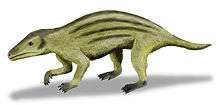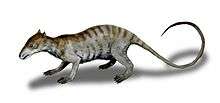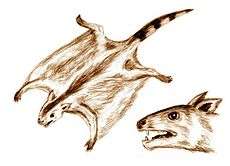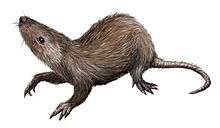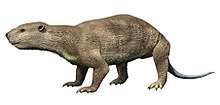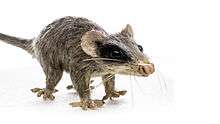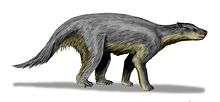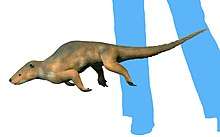Megazostrodon
Megazostrodon is an extinct Mammaliaform from South Africa that is widely accepted as being one of the first mammals. It is approximately 200 million years old.[2] Megazostrodon rudnerae means, literally, ‘Rudner’s large girdle tooth’ (from the Greek mega-large, zostros-girdle and don-tooth — referring to the founder, Ione Rudner, and the large external cingula, or ridges of the upper molars).
| Megazostrodon | |
|---|---|
 | |
| Megazostrodon model, Natural History Museum, London | |
| Scientific classification | |
| Kingdom: | Animalia |
| Phylum: | Chordata |
| Clade: | Therapsida |
| Clade: | Cynodontia |
| Family: | †Megazostrodontidae |
| Genus: | †Megazostrodon Crompton & Jenkins, 1968[1] |
| Type species | |
| Megazostrodon rudnerae Crompton & Jenkins, 1968[1] | |
Characteristics
Megazostrodon was a small, shrew-like animal between 10 to 12 centimetres (3.9 to 4.7 in) long which probably ate insects and small lizards. It is thought to have been nocturnal as it had a much larger brain[2] than its cynodont relatives and the enlarged areas of its brain were found to be those that process sounds and smells. This was probably in order to avoid being in competition with the reptiles or becoming prey to the dinosaurs.[3]
Although considered a mammal (or mammaliaform), it did have some non-mammalian characteristics inherited from its predecessors: the first two vertebrae (atlas and axis) were still unfused as in cynodonts, and it only had three sacral vertebrae instead of the usual mammalian five.[4] An interclavicle is also present, another trait inherited from non-mammlian cynodonts, and still present in monotremes.
Evolution
Megazostrodon is the only well-known genus of the family Megazostrodontidae, part of the larger group called Morganucodonta. The other members of this family that are currently known are Indozostrodon, Dinnetherium, Wareolestes and Brachyzostrodon. The megazostrodontids used to be classified as members of a group of mammals called the Triconodonts, which are thought to have evolved from a specific group of cynodonts[5] during the late Triassic and early Jurassic periods. However, recent classifications consider the megazostrodontids to be mammaliaforms outside of the stricter grouping of Mammalia proper, while the triconodonts remain in the (crowngroup) Mammalia. The distinction between true Mammalia and Mammaliaformes is purely a cladistic and phylogenetic one: mammaliaforms are mammals in the general sense of the word.
These early mammals developed many traits which were to make them well-suited for a very active lifestyle. They developed four types of teeth[6] (as opposed to the uniform teeth of the reptiles), incisors, canines, premolars and molars, which enabled them to chew and therefore process their food more thoroughly than their reptilian cousins. There is evidence that the movement of the mandible allowed a shearing action to chew food.[7] Their skeletons changed so that their limbs were more mobile, being less laterally splayed,[8] and allowing faster forward motion. They had a shorter ribcage and larger lungs[6] which allowed more efficient respiration. Their lower jaw comprised a single bone — the dentary (as opposed to the multiple bones in the jaws of their ancestors, or seven different bones found in reptilian lower jaws). The other bones which once made up the jaw had reduced, and in later mammals would become incorporated into the middle ear,[2] enhancing their hearing.
Probably the most important change in the evolution of the first mammals was that their ancestors, the cynodonts, had become warm-blooded. This meant that they generated their own body heat, relying on the food they ate to help sustain their body temperature rather than depending on their surrounding environment. This permitted higher, more sustained activity levels during the day than reptiles (reptiles must frequently perform temperature regulation activities such as sun basking and seeking shade). It was probably the key to becoming nocturnal — a major advantage in a world where most predators were active during the day.
- Phylogeny [9]
| Mammaliaformes |
| ||||||||||||||||||||||||||||||||||||||||||||||||
Reproduction
Like placentals and possibly Erythrotherium, Megazostrodon is unique among mammaliformes in lacking epipubic bones. [10] It is likely that Megazostrodon, like all early mammals and the modern monotremes, laid eggs.
Discovery
Megazostrodon rudnerae was first discovered in 1966 in Lesotho, southern Africa, by palaeontologist and archaeologist, Ione Rudner. Her surname was given to the animal's specific name).[11] It was first described by A.W. Crompton and F.A. Jenkins Jr in 1968.[1]
See also
References
- Crompton; Jenkins (1968). "Molar occlusion in late Triassic mammals". Biological Reviews. 43: 427–458. doi:10.1111/j.1469-185x.1968.tb00966.x.
- Fur and Fangs: Mammal Origins Archived 2011-06-05 at the Wayback Machine. Palaeobiology and Biodiversity Research Group, University of Bristol.
- Smithsonian Science Abstract
- Kemp, The Origin and Evolution of Mammals, (2004). Oxford Univ. Press, p. 146.
- Mammalogy Archived 2006-10-27 at the Wayback Machine Sam Houston State University.
- First Mammals Appear
- Savage, R.J.G. & Long, M.R. (1986). Mammal Evolution: an illustrated guide. Facts On File Inc. p. 41. ISBN 0-8160-1194-X.
- Mammalian Characteristics. Sam Houston State University.
- Close, Roger A.; Friedman, Matt; Lloyd, Graeme T.; Benson, Roger BJ (2015). "Evidence for a mid-Jurassic adaptive radiation in mammals". Current Biology. 25 (16): 2137–2142. doi:10.1016/j.cub.2015.06.047. PMID 26190074.
- Jason A. Lillegraven, Zofia Kielan-Jaworowska, William A. Clemens, Mesozoic Mammals: The First Two-Thirds of Mammalian History, University of California Press, 17/12/1979 - 321
- Dinosaur Mailing List

